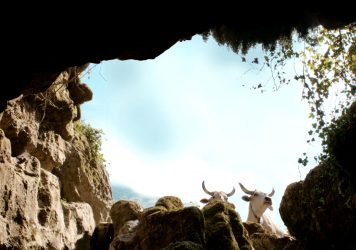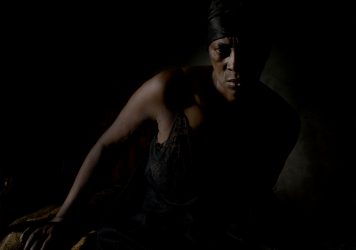
The Italian filmmaker on his slow-cooked wonder, Il Buco, and the artistic joys of discovering something new.
It has been more than ten years since Michelangelo Frammartino’s philosophical and metaphysical pastoral reverie Le Quattro Volte debuted to critical acclaim. Now, the director finally returns to our screens with his next feature film, another slow and thought-provoking exploration of the Calabrian landscape, Il Buco (or “The Hole”). A hybrid of documentary and fiction in the same vein as the director’s previous work, it is set in the early 1960s it follows a team of Piedmontese speleologists as they attempt to chart the inky darkness of the Bifurto cave system.
LWLies: Where did the initial idea for Il Buco first come from?
Frammartino: To start with, the core theme was that of boundaries. People thought they knew this territory well, but then they were made aware of the caves and realised that beneath the surface there was a whole new world to be discovered. So, making the film was about going underground, both in a physical and metaphorical sense. You know, if you use Google Earth, the whole world has been mapped – with my son I might look online to see what it is like on the top of a mountain – but speleologists are still explorers. There are still places that nobody has ever been to, no human has ever been to; it happened even to me! I was the first person in a certain region of a cave. The purpose of art is to explore the ineffable. So that idea was intriguing, but once we found out that this particular cave had been explored for the first time in 1961, which has a specific historical connotation for Italy, this made it even more irresistible.
I wanted to ask about that historical context. I assume international audiences are perhaps more familiar with the connotations of an image of JFK, as seen in the film, that they are with something like ‘il boom economico’?
It’s a really interesting point because although the shoot was very much Italian, the production team was international. Every time we screened with them present, there would be unexpected observations, so showing the film to international audiences wasn’t the first time we were confronted with a different take on the subject. For instance, certain Italian critics thought it was slightly repetitive to have the text at the beginning and end of the film, but it hammers home to the international audience what’s going on. Even though, yes, it was a period of economic growth for the rest of Europe, in Italy, it was particularly felt. We also have the divide between those in northern Italy and the south which is perhaps difficult to understand for people of other nationalities. It is still present but at that time it was particularly striking.
These two parts are represented by the high-rise in the north and the cave in the south, but also by the narrative of the shepherd who you place in direct proximity to the speleologists.
When we started going down into the cave, the first thing we noticed is how organic this journey is – it is this almost anatomical journey into the innards of the earth. I’m a teacher and I had fun showing my students pictures taken doing laparoscopy and pictures taken in the cave, side by side. They were supposed to guess which was which and were very often wrong. Giovanna [Giuliani, co-writer] and I then came across this forgotten book by a French speleologist, François Ellenberger, who found himself in a concentration camp between ’40-45. He couldn’t go exploring in the usual way, so he applied his cognition and his science to explore the body. We decided to take a little risk on this connection between the exploration of the mountain and the story of the shepherd.
That comes across quite strongly in some of your choices – particularly later in the film – when the edits really make you feel as though there are little people inside him exploring this dying body.
You know, during the editing, many times you think ‘oh this is too obvious.’ Not that my goal is to be obscure, but in all the conversations, Q&As, and reviews that have been written so far, only one person has mentioned – as you did just now – that they are inside the body, which to me was blatantly clear.
Do you think that sometimes people need an explicit framework, like the link to Pythagoras in Le Quattro Volte, to guide them?
Perhaps. What is important for me is that when you build a project there is a map of meaning. I cannot believe there is only one way to see a movie. We are working on a new project now and there are two or three ways to read it, but it’s not enough for me, so we may not do it. We need many ways to read it. The inception point of Il Buco was darkness. With Renato (Berta, DOP) we wanted to film darkness – which is, of course, unattainable because you are chasing the darkness and by chasing it you make it visible. Speleology is a tale of defeat – you are always defeated because, at some point, you just can’t go on. If you want to climb the mountain, you find yourself on the top of the mountain, so you reach your goal, but speleology is like an infinite succession of defeats. Even in the film, you see that point when they reached the bottom; no more darkness, we destroy it.
Although the map that we see has several unexplored nooks and crannies.
Yes, exactly, and this is right because, in some ways, the case never ends. This is why we have the voice of the shepherd at the end. Sound is different from image. When you explore the cave, the light, in some way, is killing the unfathomable. The light is destroying that frontier. But the sound, when you throw a stone, the stone is saying something about the shape. It’s not closing it, not killing it, because there is lots to imagine. The light is terrible, the eye is terrible – the ear is more democratic.
Little White Lies is committed to championing great movies and the talented people who make them.
Published 9 Jun 2022

This singular, awe-striking reenactment of an Italian cave exploration from the 1960s is one of the year’s major achievements.

By Mark Asch
Portuguese master Pedro Costa charts a Cape Verdean émigré’s journey through the outskirts of Lisbon.